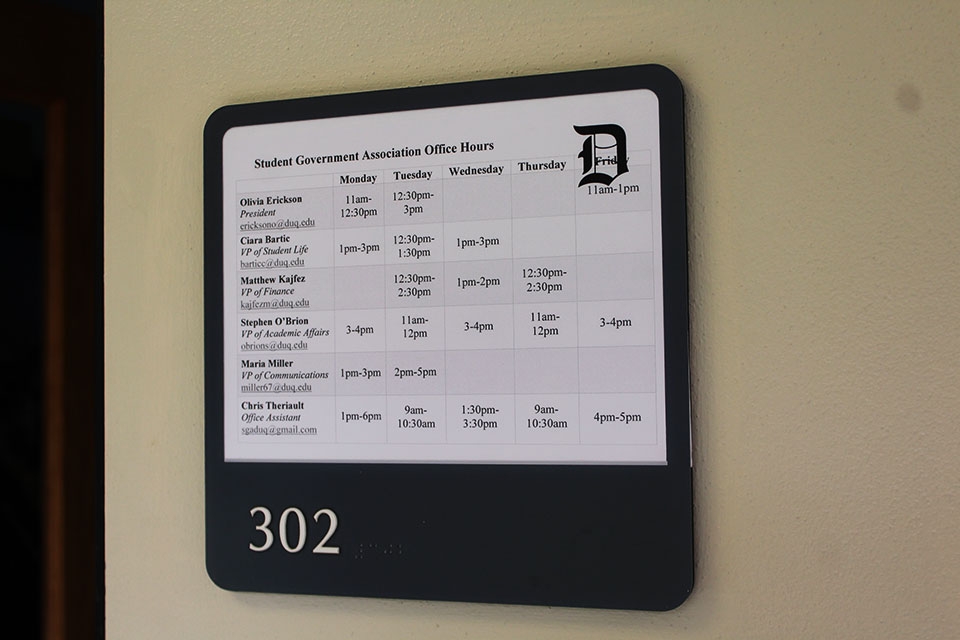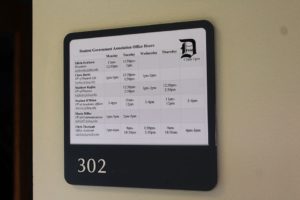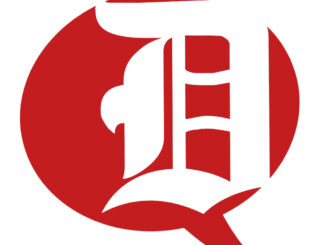
Pictured is the outside of the SGA office in 302 of the Union. Officals from the SGA sought to stop the Duke from printing budgetary information from an open meeting.

Pictured is the outside of the SGA office in 302 of the Union. Officals from the SGA sought to stop the Duke from printing budgetary information from an open meeting.
Raymond Arke | News Editor
Last week, Duquesne University Student Government Association (SGA) sought to prevent The Duke from publishing part of its annual budget that doles out money to student programs and clubs.
The Duke attended a Senate meeting of the SGA, which was open to the Duquesne public, on Aug. 27. At the meeting, the SGA budget for the school year was presented and approved by the SGA Senate.
Two members of the SGA Executive Board confronted Duke staff members in person for several hours on Wednesday night, asking for The Duke to not print the budgetary information. After Duke staff decided to run the graphic,SGA Executive Board officials, including several who ran on a platform of transparency, filed a request for prior restraint to the University Publications Board just as The Duke was going to print on Aug. 30. The Duke published a pie chart with budgetary information on page A-3 last week.
The letter, addressed to Publications Board Chair and professor of journalism, Margaret Patterson, asked for an “injunction against the Duquesne Duke, preventing them from publishing any information relating to the SGA budget.”
In the letter, SGA officials said that the budget is too “sensitive” to be publicly released.
“All Proprietary Information is sensitive due to the potential for certain information pertaining to individual organizations or line items and said information could be used in ways that violate SGA rules regarding the disclosure and use of budgetary and financial information,” the letter read.
The SGA said that to publish the information, The Duke would have to receive “the express consent of [the SGA] by a 3/5 majority procedural vote of the Senate.”
In a response to the SGA demand, Patterson said in an email that “The Publication Board does not have the authority to issue injunctions or order prior restraint with student-run publications.”
SGA President Olivia Erickson could not be reached for comment.
Leah Devorak, editor-in-chief of The Duke, said that deciding to publish the information was “very simple.”
“Not only was it obtained in a completely ethical manner during a public meeting … [it is] incredibly newsworthy for students and faculty to know,” she said and noted that the reporter was wearing visible press credentials.
Devorak also pushed back on the idea that releasing the information could be damaging.
“It is nothing but budgetary information, which should be made public and readily available in the first place,” she said. “I was simply doing my job and there’s nothing wrong with that.”
The information at the center of the controversy detailed that the SGA received a budget of $81,484 for the 2017-18 school year. The largest amount of money, 48.8 percent, falls under the jurisdiction of President Olivia Erickson. Specific line items under the President’s control include $32,000 to the Loop Bus program, $2,200 for the Readership program, $2,105 for Executive Board contingency, $2,000 for the Senior Awards ceremony, $750 for new initiatives and $700 for the Spring into Finals program.
The Vice President of Finance, Matthew Kajfez, received the second highest amount of the budget, with 34.9 percent. The largest amount of that, $23,100, is for the conference appropriations which the SGA gives to student organizations that apply. The Vice President of Finance also received $3,000 for service grants; $1,300 for supplies, like the SGA office copier and phone and $750 for the Student Resource Center located in the Student Union.
The Vice President of Student Life, Ciara Bartic, was given 5.8 percent of the budget, $2,500 of which will go toward the Night of Lights event. Other line items under Bartic include $1,000 for spirit initiatives and Homecoming, $1,000 for the SGA end of year banquet and $300 for the Pittsburgh Student Government Council conference.
Stephen O’Brion, vice president of academic affairs, controls 5.4 percent of the SGA budget. His section is spent accordingly on programs with $2,800 for the Study Break, $250 for the Book Loan and $1,350 for faculty initiatives.
The Vice President of Communications, Maria Miller, handles 3.6 percent of the budget. Marketing is given $1,500, leadership initiatives consist of $500, $700 is budgeted for Senate activities and $200 is for recruitment.
The final section of the budget is titled Senate Contingency and is 1.4 percent of the total. This includes $1,159 for annual disbursements.




